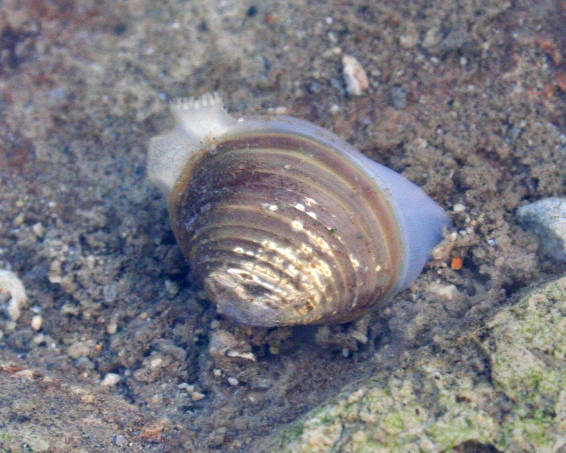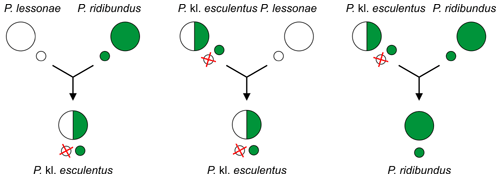|
Gynogenesis
Gynogenesis, a form of parthenogenesis, is a system of asexual reproduction that requires the presence of sperm without the actual contribution of its DNA for completion. The paternal DNA dissolves or is destroyed before it can fuse with the egg. The egg cell of the organism is able to develop, unfertilized, into an adult using only maternal genetic material. Gynogenesis is often termed "sperm parasitism" in reference to the somewhat pointless role of male gametes. Gynogenetic species, "gynogens" for short, are unisexual, meaning they must mate with males from a closely related bisexual species that normally reproduces sexually. Gynogenesis is a disadvantageous mating system for males, as they are unable to pass on their DNA. The question as to why this reproductive mode exists, given that it appears to combine the disadvantages of both asexual and sexual reproduction, remains unsolved in the field of evolutionary biology. The male equivalent to this process is androgenesis where th ... [...More Info...] [...Related Items...] OR: [Wikipedia] [Google] [Baidu] |
Klepton
In biology, a klepton (abbreviated kl.) and synklepton (abbreviated sk.) is a species that requires input from another biological taxon (normally from a species which is closely related to the kleptonic species) to complete its reproductive cycle. Specific types of kleptons are ''zygokleptons'', which reproduce by zygogenesis; ''gynokleptons'' which reproduce by gynogenesis, and ''tychokleptons'', which reproduce by a combination of both systems. Kleptogenic reproduction results in three potential outcomes: * A unisexual female may simply activate cell division in the egg through the presence of a male's sperm without incorporating any of his genetic material—this results in the production of clonal offspring. * The female may also incorporate the male's sperm into her egg, but can do so without excising any of her genetic material. This results in increased ploidy levels that range from triploid to pentaploid in wild individuals. * Finally, the female also has the option of ... [...More Info...] [...Related Items...] OR: [Wikipedia] [Google] [Baidu] |
Parthenogenesis
Parthenogenesis (; from the Greek + ) is a natural form of asexual reproduction in which the embryo develops directly from an egg without need for fertilization. In animals, parthenogenesis means the development of an embryo from an unfertilized Gametophyte, egg cell. In plants, parthenogenesis is a component process of apomixis. In algae, parthenogenesis can mean the development of an embryo from either an individual sperm or an individual egg. Parthenogenesis occurs naturally in some plants, algae, invertebrate animal species (including nematodes, some tardigrades, water fleas, some scorpions, aphids, some mites, some bees, some Phasmatodea, and parasitic wasps), and a few vertebrates, such as some fish, amphibians, and reptiles. This type of reproduction has been induced artificially in animal species that naturally reproduce through sex, including fish, amphibians, and mice. Normal egg cells form in the process of meiosis and are haploid, with half as many chromosomes as t ... [...More Info...] [...Related Items...] OR: [Wikipedia] [Google] [Baidu] |
Poecilia Formosa
The Amazon molly (''Poecilia formosa'') is a freshwater fish native to the warm waters of northeastern Mexico and the southern parts of the U.S. state of Texas. It reproduces through gynogenesis, and essentially all individuals are females. The common name of "Amazon molly," acknowledges this trait as a reference to the Amazon warriors, a female-run society in Greek mythology. The Amazon molly is a hybrid species, and its parent species are the sailfin molly (''Poecilia latipinna'') and the Atlantic molly (''Poecilia mexicana''). In 1932, this species was the first vertebrate confirmed to be capable of asexual reproduction. ''Poecilia formosa'' gets its name from the Greek ''poikilos'' meaning "variegated" or "speckled," and the Latin ''formosa'' meaning "beautiful." Species description The Amazon molly shares many of the same general characteristics of its parent species. Some of these characteristics include a rounded caudal fin, a small anal fin, small pelvic fins, pectoral fi ... [...More Info...] [...Related Items...] OR: [Wikipedia] [Google] [Baidu] |
Gynogenesis With Haplodiploidy
Gynogenesis, a form of parthenogenesis, is a system of asexual reproduction that requires the presence of sperm without the actual contribution of its DNA for completion. The paternal DNA dissolves or is destroyed before it can fuse with the egg. The egg cell of the organism is able to develop, unfertilized, into an adult using only maternal genetic material. Gynogenesis is often termed "sperm parasitism" in reference to the somewhat pointless role of male gametes. Gynogenetic species, "gynogens" for short, are unisexual, meaning they must mate with males from a closely related bisexual species that normally reproduces sexually. Gynogenesis is a disadvantageous mating system for males, as they are unable to pass on their DNA. The question as to why this reproductive mode exists, given that it appears to combine the disadvantages of both asexual and sexual reproduction, remains unsolved in the field of evolutionary biology. The male equivalent to this process is androgenesis where th ... [...More Info...] [...Related Items...] OR: [Wikipedia] [Google] [Baidu] |
Blue-spotted Salamander
The blue-spotted salamander (''Ambystoma laterale'') is a mole salamander native to the Great Lakes states and northeastern United States, and parts of Ontario and Quebec in Canada. Their range is known to extend to James Bay to the north, and southeastern Manitoba to the west. Description Blue-spotted salamanders are between in length, of which the tail comprises 40%. Generally, males are slightly smaller than their female counterparts (Donato 2000). Their skin is bluish-black, with characteristic blue and white flecks on its back, and bluish-white spots on the sides of its body and tail. They have elongated bodies. The vent is typically black, which contrasts with the paler belly. Larvae that have transformed may have yellow splotches; these turn blue once the individual becomes terrestrial. Occasionally, a melanistic individual may be found in the wild. They have long toes: four on the front feet and five on the hind feet. Typically, specimens will have 12–14 costal groov ... [...More Info...] [...Related Items...] OR: [Wikipedia] [Google] [Baidu] |
Sexual Reproduction
Sexual reproduction is a type of reproduction that involves a complex life cycle in which a gamete ( haploid reproductive cells, such as a sperm or egg cell) with a single set of chromosomes combines with another gamete to produce a zygote that develops into an organism composed of cells with two sets of chromosomes ( diploid). This is typical in animals, though the number of chromosome sets and how that number changes in sexual reproduction varies, especially among plants, fungi, and other eukaryotes. In placental mammals, sperm cells exit the penis through the male urethra and enter the vagina during copulation, while egg cells enter the uterus through the oviduct. Other vertebrates of both sexes possess a cloaca for the release of sperm or egg cells. Sexual reproduction is the most common life cycle in multicellular eukaryotes, such as animals, fungi and plants. Sexual reproduction also occurs in some unicellular eukaryotes. Sexual reproduction does not occur in pro ... [...More Info...] [...Related Items...] OR: [Wikipedia] [Google] [Baidu] |
Androgenesis
Androgenesis is a system of asexual reproduction that requires the presence of eggs and occurs when a zygote is produced with only paternal nuclear genes. During standard sexual reproduction, one female parent and one male parent each produce haploid gametes (such as a sperm or egg cell, each containing only a single set of chromosomes), which recombine to create offspring with genetic material from both parents. However, in androgenesis, there is no recombination of maternal and paternal chromosomes, and only the paternal chromosomes are passed down to the offspring. (The inverse of this is gynogenesis, where only the maternal chromosomes are inherited, which is more common than androgenesis). The offspring produced in androgenesis will still have maternally inherited mitochondria, as is the case with most sexually reproducing species. One of two things can occur to produce offspring with exclusively paternal genetic material: the maternal nuclear genome can be eliminated fr ... [...More Info...] [...Related Items...] OR: [Wikipedia] [Google] [Baidu] |
Asexual Reproduction
Asexual reproduction is a type of reproduction that does not involve the fusion of gametes or change in the number of chromosomes. The offspring that arise by asexual reproduction from either unicellular or multicellular organisms inherit the full set of genes of their single parent and thus the newly created individual is genetically and physically similar to the parent or an exact clone of the parent. Asexual reproduction is the primary form of reproduction for single-celled organisms such as archaea and eubacteria, bacteria. Many Eukaryote, eukaryotic organisms including plants, animals, and Fungus, fungi can also reproduce asexually. In Vertebrate, vertebrates, the most common form of asexual reproduction is parthenogenesis, which is typically used as an alternative to sexual reproduction in times when reproductive opportunities are limited. Some Monitor lizard, monitor lizards, including Komodo dragons, can reproduce asexually. While all prokaryotes reproduce without the fo ... [...More Info...] [...Related Items...] OR: [Wikipedia] [Google] [Baidu] |
Myrmecia Impaternata
''Myrmecia impaternata'' is a species of gynogenetic, female-only ant in the genus '' Myrmecia''. Described by Robert Taylor in 2015, the species is endemic to Australia and is common in Canberra and around Armidale. Observations of the species have been confirmed in Queensland. ''Myrmecia impaternata'' is a hybrid species Hybrid speciation is a form of speciation where hybridization between two different species leads to a new species, reproductively isolated from the parent species. Previously, reproductive isolation between two species and their parents was tho ..., with its origin tracing back to '' Myrmecia banksi'' and '' Myrmecia pilosula''. References impaternata Hymenoptera of Australia Insects described in 2015 Insects of Australia {{Myrmeciinae-stub ... [...More Info...] [...Related Items...] OR: [Wikipedia] [Google] [Baidu] |
Mole Salamander
The mole salamanders (genus ''Ambystoma'') are a group of Salamandroidea, advanced salamanders endemic to North America. The group has become famous due to the study of the axolotl (''A. mexicanum'') in research on neoteny, paedomorphosis, and the tiger salamander (''A. tigrinum, A. mavortium'') which is often sold as a pet, and is the List of U.S. state amphibians, official amphibian of four US states. General description Terrestrial animal, Terrestrial mole salamanders are identified by having wide, protruding eyes, prominent costal grooves, and thick arms. Most have vivid patterning on dark backgrounds, with marks ranging from deep blue spots to large yellow bars depending on the species. Terrestrial adults spend most of their lives underground in burrows, either of their own making or abandoned by other animals. Some northern species may hibernation, hibernate in these burrows throughout the winter. They live alone and feed on any available invertebrate. Adults spend little ... [...More Info...] [...Related Items...] OR: [Wikipedia] [Google] [Baidu] |
Hybridogenesis In Water Frogs
The Fertility, fertile Hybrid (biology), hybrids of Pelophylax, European water frogs (genus ''Pelophylax'') reproduce by hybridogenesis (hemiclonally). This means that during gametogenesis, they discard the genome of one of the parental species and produce gametes of the other parental species (containing a genome not genetic recombination, recombined with the genome of the first parental species). The first parental genome is restored by fertilization of these gametes with gametes from the first species (Sexual reproduction, sexual Host (biology), host). In all-hybrid populations of the edible frog ''Pelophylax'' Klepton, kl. ''esculentus'', however, Polyploidy, triploid hybrids provide this missing genome. Because half of the genome is transmitted to the next generation Clone (cell biology), clonally (not excluded unrecombined intact genome), and only the other half sexually (recombined genome of the sexual host), the hybridogenesis is a hemiclonal mode of reproduction. For exa ... [...More Info...] [...Related Items...] OR: [Wikipedia] [Google] [Baidu] |







